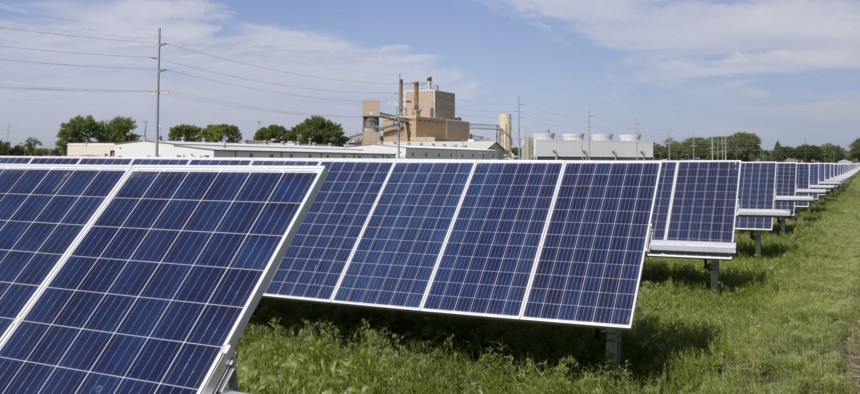The States That Gained and Lost The Most Solar Energy Jobs Last Year

In this May 31, 2018, photo, a solar panel array collects sun light with the Fremont, Neb., power plant seen behind it. AP Photo/Nati Harnik

Connecting state and local government leaders
Overall the industry shed about 8,000 positions in 2018.
Jobs nationwide in the solar energy sector declined by about 3 percent last year from 2017 amid uncertainties over trade and state policies, according a group that tracks trends in the industry.
Even though the overall number of jobs dipped by about 8,000 to around 242,000 as of last November, some states saw gains.
Leading the 29 states with solar job increases was Florida, which added 1,769 positions. The Sunshine State was followed by Illinois, which added 1,308 jobs, Texas, 739 and New York, 718.
States that saw the largest declines in solar jobs included California, which lost about 9,500 jobs. Massachusetts was down 1,320 jobs in the sector, North Carolina, 903, Arizona, 857 and Maryland, 808.
The Solar Foundation, a nonprofit that advocates for solar energy, detailed the trends in its latest National Solar Jobs Census report, which it has published annually since 2010.
Longer-term employment trends in the industry are positive, the group says in its report, with jobs in the sector increasing by about 70 percent, or around 99,600, between 2013 and 2018.
The solar sector now employs about twice as many people as the coal industry, and ranks third behind the oil and natural gas when it comes to the number of jobs in the broader energy sector, the report says.
About 155,000 jobs, or upwards of 60 percent, of the positions in the solar industry are tied to installation and project development.
Solar energy amounts to about 2.4 percent of the electricity generated nationwide, according to the foundation.
The group partly chalks up sluggishness in the solar capacity being added last year in the U.S. to a trade dispute.
That case originated in 2017 when two solar manufacturers petitioned the U.S. International Trade Commission to impose tariffs on certain imported solar technology that is widely used.
During 2017 and into January 2018 "uncertainty around the outcome of this petition made it more difficult for U.S. solar project developers to price, bid, and contract for future projects," the report says.
It goes on to note that the uncertainty over the case resulted in some projects being postponed.
In January last year, the Trump administration set tariffs at 30 percent (with 5 percentage point annual decreases through 2022) for the module and cell technology that was at the center of the trade case.
The Solar Foundation says the trade case hindered the solar industry in California, where about 40 percent of U.S. solar energy capacity is based. There were other factors in play there as well, such as uncertainties over utility rate structures.
California had added about 24,500 solar jobs in 2016, according to the group's report.
In Massachusetts, meanwhile, another state where there were solar job losses last year, the launch of a solar incentive program was delayed before finally getting off the ground last September.
The findings in the Solar Foundation report come as some liberal Democrats in Congress are calling for a "Green New Deal" to curb carbon emissions and address climate change.
One of the goals outlined in the plan put forward by freshman Rep. Alexandria Ocasio-Cortez of New York and Sen. Edward Markey of Massachusetts, is to meet 100 percent of power demand in the U.S. with clean, renewable and emission free energy sources.
A full copy of the Solar Foundation report can be found here.
Bill Lucia is a Senior Reporter for Route Fifty and is based in Olympia, Washington.

NEXT STORY: Pennsylvania Governor Says Workforce Training ‘Must Break From the Status Quo’





